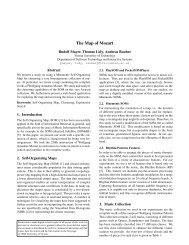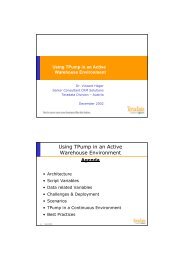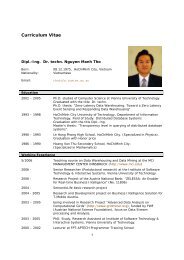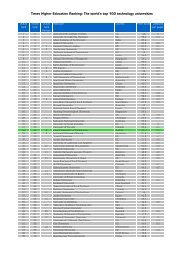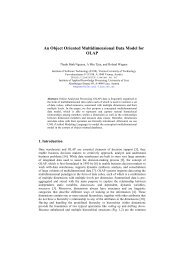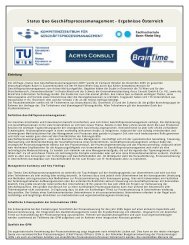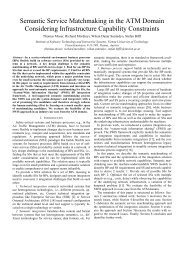Using Ontologies for Enterprise Architecture Model Alignment
Using Ontologies for Enterprise Architecture Model Alignment
Using Ontologies for Enterprise Architecture Model Alignment
You also want an ePaper? Increase the reach of your titles
YUMPU automatically turns print PDFs into web optimized ePapers that Google loves.
4 G. Antunes, A. Caetano et al.<br />
– Viewpoint-orientation. The architecture supports defining views over subsets<br />
of its concepts. This facilitates communication because viewpoints act as<br />
a separation of concerns mechanism. Viewpoints facilitate addressing multiple<br />
concerns and can improve decision-making by isolating certain aspects of the<br />
architecture according to the needs of stakeholders.<br />
– Expressiveness. The architecture represents a set of unambiguous domain<br />
concepts. This entails defining the minimum set of consistent types and relationships<br />
to describe the domain.<br />
– Extensibility. The architecture supports the integration of multiple domainspecific<br />
and domain-independent meta-models while minimizing coupling.<br />
– Modularity. The architecture observes high-cohesion and low-coupling. Observing<br />
these qualities contributes to the expressiveness and extensibility of<br />
the architecture with the goal of minimizing the impact of adding new domainspecific<br />
concepts.<br />
The framework uses a core meta-model to <strong>for</strong>malize the concepts that are<br />
domain-independent This meta-model is <strong>for</strong>malized as an upper-level ontology<br />
and is designated domain-independent ontology (DIO). The design goal of the<br />
DIO is to identify a minimum set of concepts pertaining to the central modelling<br />
domain (in this case, enterprise architecture). The concepts of the DIO<br />
are extended by defining a variable number of domain-specific meta-models,<br />
depending on the particular system concern. Each domain-specific meta-model<br />
is <strong>for</strong>malized as a domain-specific ontology (DSO). Thus, a DSO represents a<br />
domain-specific language that addresses a particular set of concerns, and should<br />
also have the minimum set of concepts required <strong>for</strong> describing a determined domain.<br />
There<strong>for</strong>e, separation of concerns, low-coupling and high-cohesion are the<br />
primary qualities that affect the DIO and DSO design.<br />
Ontology integration is required to link concepts from the DIO to the DSO.<br />
Integration combines different ontologies while ensuring consistency and maximum<br />
coverage of the domain being addressed. The simplest case is that of<br />
integrating the DSO concepts with the core concepts represented in the DIO.<br />
Cross-DSO integration occurs whenever more expressiveness power to specific<br />
domains. The ontology integration makes use of model trans<strong>for</strong>mation, which<br />
involves defining a mapping strategy from a source model to a target model<br />
[34, 35]. Figure 1 depicts the types of trans<strong>for</strong>mation maps between the DIO<br />
and the DSOs. A map attempts to relate the concepts from a source to a destination<br />
ontology so that there is a one-to-one correspondence between each<br />
pair of concepts. Three types of mapping deficiencies may occur [36]. A source<br />
concept may map to more than one destination concept resulting in overload,<br />
a source concept may not be mappable to any destination resulting in deficit,<br />
or several source concepts may map to the same destination concept leading to<br />
redundancy.<br />
The models that result from instantiating the integrated DIO and DSO can<br />
be analysed and properties and relations can be inferred through reasoners. Four<br />
types of reasoning are possible with this architecture:DIO reasoning when inference<br />
is limited to the DIO concepts, DSO reasoning, when inference is limited



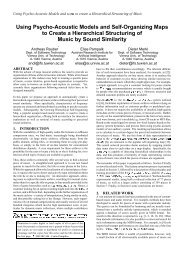


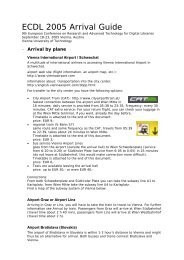
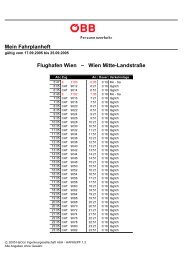
![Informationsvisualisierung [WS0708 | 01 ]](https://img.yumpu.com/22537403/1/190x143/informationsvisualisierung-ws0708-01-.jpg?quality=85)
